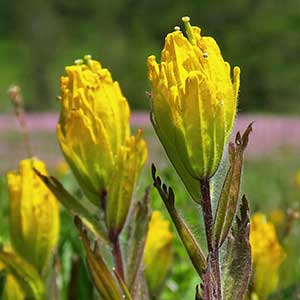Castilleja levisecta
Castilleja chambersii
golden Indian paintbrush, golden paintbrush
Chambers' Indian paintbrush, Chambers' paintbrush
few to many, erect, ± decumbent or creeping at base, unbranched, sometimes branched, hairs spreading, medium length and long, soft, mixed with short stipitate-glandular ones.
solitary or few to several, ascending, sometimes short-decumbent and rooting, branched from near base, sometimes distally, glabrous or glabrate with hairs very sparse, ± appressed, very short, soft, eglandular.
green to purple or brown-tinged, linear-lanceolate proximally, oblong-ovate or -obovate distally, 0.8–5.2 cm, not fleshy, margins plane, distalmost sometimes ± wavy, involute, 3–7(–11)-lobed, apex obtuse;
lobes erect to ascending, linear to linear-spatulate, very short, toothlike, usually arising from distal 1/3 of blade, apex rounded.
green, often brown- or purple-tinged, oblong to lanceolate to narrowly ovate or ovate, (1–)2–5.8 cm, not fleshy, margins plane, ± involute, deeply 3–7(–11)-lobed, sometimes with secondary lobes, apex narrowly acute;
lobes erect to ascending, lanceolate to linear-lanceolate to oblanceolate, apex acute.
2.5–25 × 1–4 cm;
bracts bright yellow throughout, or proximally greenish, distally bright yellow, sometimes deep yellow-orange, especially with age, oblong, elliptic, or obtuse to ovate, (0–)5–9(–13)-lobed, sometimes wavy-margined;
lobes erect to ascending, oblong, short to medium length, arising above mid length, central lobe apex rounded, lateral ones rounded to acute.
3–15 × 2–4.5 cm;
bracts proximally greenish, distally bright red, scarlet, or pale reddish orange, rarely orange-yellow, often fading to pale yellowish orange with age, obovate to orbicular, fan-shaped, (3–)5–9(–13)-lobed, sometimes with secondary lobes;
lobes erect or ascending, lanceolate to triangular, short and medium length, usually arising at or above mid length, rarely below, apex acute.
straight or slightly curved, 17–28 mm;
tube 12–15 mm;
beak exserted, adaxially green or greenish yellow, 6–8 mm;
abaxial lip yellow or greenish, reduced, not inflated, 2–3 mm, 25–33(–50)% as long as beak;
teeth ascending to erect, yellow, 0.5–1.5 mm.
straight, 30–45 mm;
tube 14–19 mm;
beak long-exserted, adaxially green or yellow-green to brownish, 18–24 mm;
abaxial lip deep green, reduced, 1–3 mm, 10% as long as beak;
teeth incurved, greenish to dull purplish, 0.5–1.5 mm.
distally yellow, 13–22 mm;
abaxial and adaxial clefts 4–9.5 mm, 30–40% of calyx length, deeper than laterals, lateral 2.5–4.5 mm, ca. 25% of calyx length;
lobes linear to narrowly oblong or narrowly lanceolate, apex obtuse, sometimes rounded to acute.
proximally green, sometimes purple to brown, distally colored as bracts, 20–30 mm;
abaxial and adaxial clefts 7–14 mm, ca. 33% of calyx length, deeper than laterals, lateral 2–4 mm, 10–15% of calyx length;
lobes triangular, barely longer than wide, apex acute or acuminate to obtuse.
= 24.
= 24.
Castilleja levisecta
Castilleja chambersii
Castilleja levisecta is listed as threatened in the United States and endangered in Canada, where it is extremely rare. Most of its grassland habitat has been altered by development in the Puget Trough, and there are historical stations in the metro areas of what are now Victoria, Portland, and Seattle. For several decades, C. levisecta was considered extirpated from Oregon. However, recent reintroduction programs in Oregon and Washington have been very successful at reestablishing this species at several sites in the Willamette Valley. The bright yellow inflorescences often gradually age to a golden yellow color, unique in the genus.
Castilleja levisecta is in the Center for Plant Conservation’s National Collection of Endangered Plants.
(Discussion copyrighted by Flora of North America; reprinted with permission.)
Castilleja chambersii is limited to the summits of three volcanic peaks in the northern Coast Range of Clatsop County, Oregon, and at one similar area in nearby Pacific County, Washington. It is similar to C. rupicola, and the two likely share a common ancestor. Disturbance and erosion from logging and road construction represent significant threats to C. chambersii. Populations of C. chambersii often grow near and even alongside C. hispida, but hybrids are rare.
(Discussion copyrighted by Flora of North America; reprinted with permission.)



